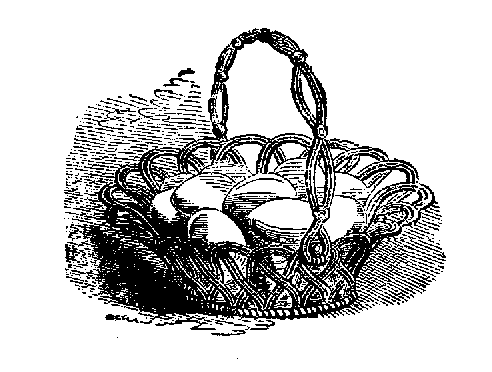
SEPARATION OF MILK AND CREAM.
1627.
If it be desired that the milk should be freed entirely from cream, it should be poured into a very shallow broad pan or dish, not more than 1-1/2 inch deep, as cream cannot rise through a great depth of milk. In cold and wet weather, milk is not so rich as it is in summer and warm weather, and the morning's milk is always richer than the evening's. The last-drawn milk of each milking, at all times and seasons, is richer than the first-drawn, and on that account should be set apart for cream. Milk should be shaken as little as possible when carried from the cow to the dairy, and should be poured into the pans very gently. Persons not keeping cows, may always have a little cream, provided the milk they purchase be pure and unadulterated. As soon as it comes in, it should be poured into very shallow open pie-dishes, and set by in a very cool place, and in 7 or 8 hours a nice cream should have risen to the surface.MILK is one of the most complete of all articles of food: that is to say, it contains a very large number of the elements which enter into the composition of the human body. It "disagrees" with fat, heavy, languid people, of slow circulation; and, at first, with many people of sedentary habits, and stomachs weakened by stimulants of different kinds. But, if exercise can be taken and a little patience shown, while the system accommodates itself to a new regimen, this bland and soothing article of diet is excellent for the majority of thin, nervous people; especially for those who have suffered much from emotional disturbances, or have relaxed their stomachs by too much tea or coffee, taken too hot. Milk is, in fact, a nutrient and a sedative at once. Stomachs, however, have their idiosyncrasies, and it sometimes proves an unwelcome and ill-digested article of food. As milk, when good, contains a good deal of respiratory material (fat),-- material which must either be burnt off, or derange the liver, and be rejected in other ways, it may disagree because the lungs are not sufficiently used in the open air. But it is very probable that there are really "constitutions" which cannot take to it; and they should not be forced.
TO KEEP MILK AND CREAM IN HOT WEATHER.
1628.
When the weather is very warm, and it is very difficult to prevent milk from turning sour and spoiling the cream, it should be scalded, and it will then remain good for a few hours. It must on no account be allowed to boil, or there will be a skin instead of a cream upon the milk; and the slower the process, the safer will it be. A very good plan to scald milk, is to put the pan that contains it into a saucepan or wide kettle of boiling water. When the surface looks thick, the milk is sufficiently scalded, and it should then be put away in a cool place in the same vessel that it was scalded in. Cream may be kept for 24 hours, if scalded without sugar; and by the addition of the latter ingredient, it will remain good double the time, if kept in a cool place. All pans, jugs, and vessels intended for milk, should be kept beautifully clean, and well scalded before the milk is put in, as any negligence in this respect may cause large quantities of it to be spoiled; and milk should never be kept in vessels of zinc or copper. Milk may be preserved good in hot weather, for a few hours, by placing the jug which contains it in ice, or very cold water; or a pinch of bicarbonate of soda may be introduced into the liquid.MILK, when of good quality, is of an opaque white colour: the cream always comes to the top; the well-known milky odour is strong; it will boil without altering its appearance, in these respects; the little bladders which arise on the surface will renew themselves if broken by the spoon. To boil milk is, in fact, the simplest way of testing its quality. The commonest adulterations of milk are not of a hurtful character. It is a good deal thinned with water, and sometimes thickened with a little starch, or colored with yolk of egg, or even saffron; but these processes have nothing murderous in them.
CURDS AND WHEY.
1629.
INGREDIENTS.-- A very small piece of rennet, 1/2 gallon of milk.Mode
.-- Procure from the butcher's a small piece of rennet, which is the stomach of the calf, taken as soon as it is killed, scoured, and well rubbed with salt, and stretched on sticks to dry. Pour some boiling water on the rennet, and let it remain for 6 hours; then use the liquor to turn the milk. The milk should be warm and fresh from the cow: if allowed to cool, it must be heated till it is of a degree quite equal to new milk; but do not let it be too hot. About a tablespoonful or rather more, would be sufficient to turn the above proportion of milk into curds and whey; and whilst the milk is turning, let it be kept in rather a warm place.Time
.-- From 2 to 3 hours to turn the milk.Seasonable
at any time.DEVONSHIRE CREAM.
1630.
The milk should stand 24 hours in the winter, half that time when the weather is very warm. The milkpan is then set on a stove, and should there remain until the milk is quite hot; but it must not boil, or there will be a thick skin on the surface. When it is sufficiently done, the undulations on the surface look thick, and small rings appear. The time required for scalding cream depends on the size of the pan and the heat of the fire; but the slower it is done, the better. The pan should be placed in the dairy when the cream is sufficiently scalded, and skimmed the following day. This cream is so much esteemed that it is sent to the London markets in small square tins, and is exceedingly delicious eaten with fresh fruit. In Devonshire, butter is made from this cream, and is usually very firm.DEVONSHIRE JUNKET.
1631.
INGREDIENTS.-- To every pint of new milk allow 2 dessertspoonfuls of brandy, 1 dessertspoonful of sugar, and 1-1/2 dessertspoonful of prepared rennet; thick cream, pounded cinnamon, or grated nutmeg.Mode
.-- Make the milk blood-warm; put it into a deep dish with the brandy, sugar, and rennet; stir it altogether, and cover it over until it is set. Then spread some thick or clotted cream over the top, grate some nutmeg, and strew some sugar over, and the dish will be ready to serve.Time
.-- About 2 hours to set the milk. Seasonable at any time.TO KEEP AND CHOOSE FRESH BUTTER.
1632.
Fresh butter should be kept in a dark, cool place, and in as large a mass as possible. Mould as much only as is required, as the more surface is exposed, the more liability there will be to spoil; and the outside very soon becomes rancid. Fresh butter should be kept covered with white paper. For small larders, butter-coolers of red brick are now very much used for keeping fresh butter in warm weather. These coolers are made with a large bell-shaped cover, into the top of which a little cold water should be poured, and in summer time very frequently changed; and the butter must be kept covered. These coolers keep butter remarkably firm in hot weather, and are extremely convenient for those whose larder accommodation is limited.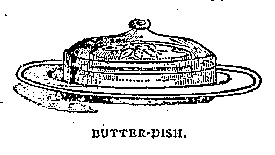
In choosing fresh butter, remember it should smell deliciously, and be of an equal colour all through: if it smells sour, it has not been sufficiently washed from the buttermilk; and if veiny and open, it has probably been worked with a staler or an inferior sort.
TO PRESERVE AND TO CHOOSE SALT BUTTER.
1633.
In large families, where salt butter is purchased a tub at a time, the first thing to be done is to turn the whole of the butter out, and, with a clean knife, to scrape the outside; the tub should then be wiped with a clean cloth, and sprinkled all round with salt, the butter replaced, and the lid kept on to exclude the air. It is necessary to take these precautions, as sometimes a want of proper cleanliness in the dairymaid causes the outside of the butter to become rancid, and if the scraping be neglected, the whole mass would soon become spoiled. To choose salt butter, plunge a knife into it, and if, when drawn out, the blade smells rancid or unpleasant, the butter is bad. The layers in tubs will vary greatly, the butter being made at different times; so, to try if the whole tub be good, the cask should be unhooped, and the butter tried between the staves.It is not necessary to state that butter is extracted from cream, or from unskimmed milk, by the churn. Of course it partakes of the qualities of the milk, and winter butter is said not to be so good as spring butter.
A word of caution is necessary about rancid butter. Nobody eats it on bread, but it is sometimes used in cooking, in forms in which the acidity can be more or less disguised. So much the worse; it is almost poisonous, disguise it as you may. Never, under any exigency whatever, be tempted into allowing butter with even a soupçon of "turning" to enter into the composition of any dish that appears on your table. And, in general, the more you can do without the employment of butter that has been subjected to the influence of heat, the better. The woman of modern times is not a "leech;" but she might often keep the "leech" from the door, if she would give herself the trouble to invent innocent sauces.
BUTTER-MOULDS, for Moulding Fresh Butter.
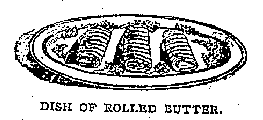
1634.
Butter-moulds, or wooden stamps for moulding fresh butter, are much used, and are made in a variety of forms and shapes. In using them, let them be kept scrupulously clean, and before the butter is pressed in, the interior should be well wetted with cold water; the butter must then be pressed in, the mould opened, and the perfect shape taken out. The butter may be then dished, and garnished with a wreath of parsley, if for a cheese course; if for breakfast, put it into an ornamental butter-dish, with a little water at the bottom, should the weather be very warm.CURLED BUTTER.
1635.
Tie a strong cloth by two of the corners to an iron hook in the wall; make a knot with the other two ends, so that a stick might pass through. Put the butter into the cloth; twist it tightly over a dish, into which the butter will fall through the knot, so forming small and pretty little strings. The butter may then be garnished with parsley, if to serve with a cheese course; or it may be sent to table plain for breakfast, in an ornamental dish. Squirted butter for garnishing hams, salads, eggs, &c., is made by forming a piece of stiff paper in the shape of a cornet, and squeezing the butter in fine strings from the hole at the bottom. Scooped butter is made by dipping a teaspoon or scooper in warm water, and then scooping the butter quickly and thin. In warm weather, it would not be necessary to heat the spoon.BUTTER may be kept fresh for ten or twelve days by a very simple process. Knead it well in cold water till the buttermilk is extracted; then put it in a glazed jar, which invert in another, putting into the latter a sufficient quantity of water to exclude the air. Renew the water every day.
FAIRY BUTTER.
1636.
INGREDIENTS.-- The yolks of 2 hard-boiled eggs, 1 tablespoonful of orange-flower water, 2 tablespoonfuls of pounded sugar, 1/4 lb. of good fresh butter.Mode
.-- Beat the yolks of the eggs smoothly in a mortar, with the orange-flower water and the sugar, until the whole is reduced to a fine paste; add the butter, and force all through an old but clean cloth by wringing the cloth and squeezing the butter very hard. The butter will then drop on the plate in large and small pieces, according to the holes in the cloth. Plain butter may be done in the same manner, and is very quickly prepared, besides having a very good effect.BUTTER.-- White-coloured butter is said not to be so good as the yellow; but the yellow colour is often artificially produced, by the introduction of colouring matter into the churn.
ANCHOVY BUTTER.
1637.
INGREDIENTS.-- To every lb. of butter allow 6 anchovies, 1 small bunch of parsley.Mode
.-- Wash, bone, and pound the anchovies well in a mortar; scald the parsley, chop it, and rub through a sieve; then pound all the ingredients together, mix well, and make the butter into pats immediately. This makes a pretty dish, if fancifully moulded, for breakfast or supper, and should be garnished with parsley.Average cost
, 1s. 8d.Sufficient
to make 2 dishes, with 4 pats each.Seasonable
at any time.CHEESE.
1638.
In families where much cheese is consumed, and it is bought in large quantities, a piece from the whole cheese should be cut, the larger quantity spread with a thickly-buttered sheet of white paper, and the outside occasionally wiped. To keep cheeses moist that are in daily use, when they come from table a damp cloth should be wrapped round them, and the cheese put into a pan with a cover to it, in a cool but not very dry place. To ripen cheeses, and bring them forward, put them into a damp cellar; and, to check too large a production of mites, spirits may be poured into the parts affected. Pieces of cheese which are too near the rind, or too dry to put on table, may be made into Welsh rare-bits, or grated down and mixed with macaroni. Cheeses may be preserved in a perfect state for years, by covering them with parchment made pliable by soaking in water, or by rubbing them over with a coating of melted fat. The cheeses selected should be free from cracks or bruises of any kind.CHEESE.-- It is well known that some persons like cheese in a state of decay, and even "alive." There is no accounting for tastes, and it maybe hard to show why mould, which is vegetation, should not be eaten as well as salad, or maggots as well as eels. But, generally speaking, decomposing bodies are not wholesome eating, and the line must be drawn somewhere.
STILTON CHEESE.
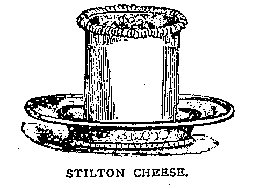
1639.
Stilton cheese, or British Parmesan, as it is sometimes called, is generally preferred to all other cheeses by those whose authority few will dispute. Those made in May or June are usually served at Christmas; or, to be in prime order, should be kept from 10 to 12 months, or even longer. An artificial ripeness in Stilton cheese is sometimes produced by inserting a small piece of decayed Cheshire into an aperture at the top. From 3 weeks to a month is sufficient time to ripen the cheese. An additional flavour may also be obtained by scooping out a piece from the top, and pouring therein port, sherry, Madeira, or old ale, and letting the cheese absorb these for 2 or 3 weeks. But that cheese is the finest which is ripened without any artificial aid, is the opinion of those who are judges in these matters. In serving a Stilton cheese, the top of it should be cut off to form a lid, and a napkin or piece of white paper, with a frill at the top, pinned round. When the cheese goes from table, the lid should be replaced.MODE OF SERVING CHEESE.
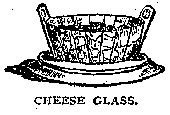
1640.
The usual mode of serving cheese at good tables is to cut a small quantity of it into neat square pieces, and to put them into a glass cheese-dish, this dish being handed round. Should the cheese crumble much, of course this method is rather wasteful, and it may then be put on the table in the piece, and the host may cut from it. When served thus, the cheese must always be carefully scraped, and laid on a white d'oyley or napkin, neatly folded. Cream cheese is often served in a cheese course, and, sometimes, grated Parmesan: the latter should he put into a covered glass dish. Rusks, cheese-biscuits, pats or slices of butter, and salad, cucumber, or water-cresses, should always form part of a cheese course.SMOKING CHEESES.-- The Romans smoked their cheeses, to give them a sharp taste. They possessed public places expressly for this use, and subject to police regulations which no one could evade.
A celebrated gourmand remarked that a dinner without cheese is like a woman with one eye.
CHEESE SANDWICHES.
1641.
INGREDIENTS.-- Slices of brown bread-and-butter, thin slices of cheese.Mode
.-- Cut from a nice fat Cheshire, or any good rich cheese, some slices about 1/2 inch thick, and place them between some slices of brown bread-and-butter, like sandwiches. Place them on a plate in the oven, and, when the bread is toasted, serve on a napkin very hot and very quickly.Time
.-- 10 minutes in a brisk oven.Average cost
, 1-1/2d. each sandwich.Sufficient
.-- Allow a sandwich for each person.Seasonable
at any time.CHEESE.-- One of the most important products of coagulated milk is cheese. Unfermented, or cream-cheese, when quite fresh, is good for subjects with whom milk does not disagree; but cheese, in its commonest shape, is only fit for sedentary people as an after-dinner stimulant, and in very small quantity. Bread and cheese, as a meal, is only fit for soldiers on march or labourers in the open air, who like it because it "holds the stomach a long time."
CAYENNE CHEESES.
1642.
INGREDIENTS.-- 1/2 lb. of butter, 1/2 lb. of flour, 1/2 lb. of grated cheese, 1/3 teaspoonful of cayenne, 1/3 teaspoonful of salt; water.Mode
.-- Rub the butter in the flour; add the grated cheese, cayenne. and salt; and mix these ingredients well together. Moisten with sufficient water to make the whole into a paste; roll out, and cut into fingers about 4 inches in length. Bake them in a moderate oven a very light colour, and serve very hot.Time
.-- 15 to 20 minutes. Average cost, 1s. 4d.Sufficient
for 6 or 7 persons. Seasonable at any time.TO MAKE A FONDUE.
1643.
INGREDIENTS.-- 4 eggs, the weight of 2 in Parmesan or good Cheshire cheese, the weight of 2 in butter; pepper and salt to taste.Mode
.-- Separate the yolks from the whites of the eggs; beat the former in a basin, and grate the cheese, or cut it into very thin flakes. Parmesan or Cheshire cheese may be used, whichever is the most convenient, although the former is considered more suitable for this dish; or an equal quantity of each may be used. Break the butter into small pieces, add it to the other ingredients, with sufficient pepper and salt to season nicely, and beat the mixture thoroughly. Well whisk the whites of the eggs, stir them lightly in, and either bake the fondue in a soufflé-dish or small round cake-tin. Fill the dish only half full, as the fondue should rise very much. Pin a napkin round the tin or dish, and serve very hot and very quickly. If allowed to stand after it is withdrawn from the oven, the beauty and lightness of this preparation will be entirely spoiled.Time
.-- From 15 to 20 minutes. Average cost, 10d.Sufficient
for 4 or 5 persons. Seasonable at any time.BRILLAT SAVARIN'S FONDUE.
(An excellent Recipe.)
1644.
INGREDIENTS.-- Eggs, cheese, butter, pepper and salt.Mode
.-- Take the same number of eggs as there are guests; weigh the eggs in the shell, allow a third of their weight in Gruyère cheese, and a piece of butter one-sixth of the weight of the cheese. Break the eggs into a basin, beat them well; add the cheese, which should be grated, and the butter, which should be broken into small pieces. Stir these ingredients together with a wooden spoon; put the mixture into a lined saucepan, place it over the fire, and stir until the substance is thick and soft. Put in a little salt, according to the age of the cheese, and a good sprinkling of pepper, and serve the fondue on a very hot silver or metal plate. Do not allow the fondue to remain on the fire after the mixture is set, as, if it boils, it will be entirely spoiled. Brillat Savarin recommends that some choice Burgundy should be handed round with this dish. We have given this recipe exactly as he recommends it to be made; but we have tried it with good Cheshire cheese, and found it answer remarkably well.Time
.-- About 4 minutes to set the mixture.Average cost
for 4 persons, 10d.Sufficient
.-- Allow 1 egg, with the other ingredients in proportion, for one person.Seasonable
at any time.MACARONI, as usually served with the CHEESE COURSE.
I.
1645.
INGREDIENTS.-- 1/2 lb. of pipe macaroni, 1/4 lb. of butter, 6 oz. of Parmesan or Cheshire cheese, pepper and salt to taste, 1 pint of milk, 2 pints of water, bread crumbs.Mode
.-- Put the milk and water into a saucepan with sufficient salt to flavour it; place it on the fire, and, when it boils quickly, drop in the macaroni. Keep the water boiling until it is quite tender; drain the macaroni, and put it into a deep dish. Have ready the grated cheese, either Parmesan or Cheshire; sprinkle it amongst the macaroni and some of the butter cut into small pieces, reserving some of the cheese for the top layer. Season with a little pepper, and cover the top layer of cheese with some very fine bread crumbs. Warm, without oiling, the remainder of the butter, and pour it gently over the bread crumbs. Place the dish before a bright fire to brown the crumbs; turn it once or twice, that it may be equally coloured, and serve very hot. The top of the macaroni may be browned with a salamander, which is even better than placing it before the fire, as the process is more expeditious; but it should never be browned in the oven, as the butter would oil, and so impart a very disagreeable flavour to the dish. In boiling the macaroni, let it be perfectly tender but firm, no part beginning to melt, and the form entirely preserved. It may be boiled in plain water, with a little salt instead of using milk, but should then have a small piece of butter mixed with it.Time
.-- 1-1/2 to 1-3/4 hour to boil the macaroni, 5 minutes to brown it before the fire.Average cost
, 1s. 6d.Sufficient
for 6 or 7 persons. Seasonable at any time.Note
.-- Riband macaroni may be dressed in the same manner, but does not require boiling so long a time.II.
1646.
INGREDIENTS.-- 1/4 lb. of pipe or riband macaroni, 1/2 pint of milk, 1/2 pint of veal or beef gravy, the yolks of 2 eggs, 4 tablespoonfuls of cream, 3 oz. of grated Parmesan or Cheshire cheese, 1 oz. of butter.Mode
.-- Wash the macaroni, and boil it in the gravy and milk until quite tender, without being broken. Drain it, and put it into rather a deep dish. Beat the yolks of the eggs with the cream and 2 tablespoonfuls of the liquor the macaroni was boiled in; make this sufficiently hot to thicken, but do not allow it to boil; pour it over the macaroni, over which sprinkle the grated cheese and the butter broken into small pieces; brown with a salamander, or before the fire, and serve.Time
.-- 1-1/2 to 1-3/4 hour to boil the macaroni, 5 minutes to thicken the eggs and cream, 5 minutes to brown.Average cost
, 1s. 2d.Sufficient
for 3 or 4 persons. Seasonable at any time.III.
1647.
INGREDIENTS.-- 1/4 lb. of pipe macaroni, 1/2 pint of brown gravy No. 436, 6 oz. of grated Parmesan cheese.Mode
.-- Wash the macaroni, and boil it in salt and water until quite tender; drain it, and put it into rather a deep dish. Have ready a pint of good brown gravy, pour it hot over the macaroni, and send it to table with grated Parmesan served on a separate dish. When the flavour is liked, a little pounded mace may be added to the water in which the macaroni is boiled; but this must always be sparingly added, as it will impart a very strong flavour.Time
.-- 1-1/2 to 1-3/4 hour to boil the macaroni.Average cost
, with the gravy and cheese, 1s. 3d.Sufficient
for 3 or 4 persons. Seasonable at any time.POUNDED CHEESE.
1648.
INGREDIENTS.-- To every lb. of cheese allow 3 oz. of fresh butter.Mode
.-- To pound cheese is an economical way of using it, if it has become dry; it is exceedingly good spread on bread, and is the best way of eating it for those whose digestion is weak. Cut up the cheese into small pieces, and pound it smoothly in a mortar, adding butter in the above proportion. Press it down into a jar, cover with clarified butter, and it will keep for several days. The flavour may be very much increased by adding mixed mustard (about a teaspoonful to every lb.), or cayenne, or pounded mace. Curry-powder is also not unfrequently mixed with it.RAMAKINS, to serve with the CHEESE COURSE.
1649.
INGREDIENTS.-- 1/4 lb. of Cheshire cheese, 1/4 lb. of Parmesan cheese, 1/4 lb. of fresh butter, 4 eggs, the crumb of a small roll; pepper, salt, and pounded mace to taste.Mode
.-- Boil the crumb of the roll in milk for 5 minutes; strain, and put it into a mortar; add the cheese, which should be finely scraped, the butter, the yolks of the eggs, and seasoning, and pound these ingredients well together. Whisk the whites of the eggs, mix them with the paste, and put it into small pans or saucers, which should not be more than half filled. Bake them from 10 to 12 minutes, and serve them very hot and very quickly. This batter answers equally well for macaroni after it is boiled tender.Time
-- 10 to 12 minutes. Average cost, 1s. 4d.Sufficient
for 7 or 8 persons. Seasonable at any time.PASTRY RAMAKINS, to serve with the CHEESE COURSE.
1650.
INGREDIENTS.-- Any pieces of very good light puff-paste Cheshire, Parmesan, or Stilton cheese.Mode
.-- The remains or odd pieces of paste left from large tarts, &c. answer for making these little dishes. Gather up the pieces of paste, roll it out evenly, and sprinkle it with grated cheese of a nice flavour. Fold the paste in three, roll it out again, and sprinkle more cheese over; fold the paste, roll it out, and with a paste-cutter shape it in any way that may be desired. Bake the ramakins in a brisk oven from 10 to 15 minutes, dish them on a hot napkin, and serve quickly. The appearance of this dish may be very much improved by brushing the ramakins over with yolk of egg before they are placed in the oven. Where expense is not objected to, Parmesan is the best kind of cheese to use for making this dish.Time
.-- 10 to 15 minutes. Average cost, with 1/2 lb. of paste, 10d.Sufficient
for 6 or 7 persons. Seasonable at any time.TOASTED CHEESE, or SCOTCH RARE-BIT.
1651.
INGREDIENTS.-- A few slices of rich cheese, toast, mustard, and pepper.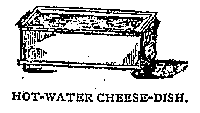
Mode.-- Cut some nice rich sound cheese into rather thin slices; melt it in a cheese-toaster on a hot plate, or over steam, and, when melted, add a small quantity of mixed mustard and a seasoning of pepper; stir the cheese until it is completely dissolved, then brown it before the fire, or with a salamander. Fill the bottom of the cheese-toaster with hot water, and serve with dry or buttered toasts, whichever may be preferred. Our engraving illustrates a cheese-toaster with hot-water reservoir: the cheese is melted in the upper tin, which is placed in another vessel of boiling water, so keeping the preparation beautifully hot. A small quantity of porter, or port wine, is sometimes mixed with the cheese; and, if it be not very rich, a few pieces of butter may be mixed with it to great advantage. Sometimes the melted cheese is spread on the toasts, and then laid in the cheese-dish at the top of the hot water. Whichever way it is served, it is highly necessary that the mixture be very hot, and very quickly sent to table, or it will be worthless.
Time
.-- About 5 minutes to melt the cheese.Average cost
, 1-1/2d. per slice.Sufficient
.-- Allow a slice to each person. Seasonable at any time.TOASTED CHEESE, or WELSH RARE-BIT.
1652.
INGREDIENTS.-- Slices of bread, butter, Cheshire or Gloucester cheese, mustard, and pepper.Mode
.-- Cut the bread into slices about 1/2 inch in thickness; pare off the crust, toast the bread slightly without hardening or burning it, and spread it with butter. Cut some slices, not quite so large as the bread, from a good rich fat cheese; lay them on the toasted bread in a cheese-toaster; be careful that the cheese does not burn, and let it be equally melted. Spread over the top a little made mustard and a seasoning of pepper, and serve very hot, with very hot plates. To facilitate the melting of the cheese, it may be cut into thin flakes or toasted on one side before it is laid on the bread. As it is so essential to send this dish hot to table, it is a good plan to melt the cheese in small round silver or metal pans, and to send these pans to table, allowing one for each guest. Slices of dry or buttered toast should always accompany them, with mustard, pepper, and salt.Time
.-- About 5 minutes to melt the cheese.Average cost
, 1-1/2d. each slice.Sufficient
.-- Allow a slice to each person. Seasonable at any time.Note
.-- Should the cheese be dry, a little butter mixed with it will be an improvement."COW CHEESE." -- It was only fifty years after Aristotle -- the fourth century before Christ -- that butter began to be noticed as an aliment. The Greeks, in imitation of the Parthians and Scythians, who used to send it to them, had it served upon their tables, and called it at first "oil of milk," and later, bouturos, "cow cheese."
SCOTCH WOODCOCK.
1653.
INGREDIENTS.-- A few slices of hot buttered toast; allow 1 anchovy to each slice. For the sauce,-- 1/4 pint of cream, the yolks of 3 eggs.Mode
.-- Separate the yolks from the whites of the eggs; beat the former, stir to them the cream, and bring the sauce to the boiling-point, but do not allow it to boil, or it will curdle. Have ready some hot buttered toast, spread with anchovies pounded to a paste; pour a little of the hot sauce on the top, and serve very hot and very quickly.Time
.-- 5 minutes to make the sauce hot.Sufficient
.-- Allow 1/2 slice to each person. Seasonable at any time.TO CHOOSE EGGS.
1654.
In choosing eggs, apply the tongue to the large end of the egg, and, if it feels warm, it is new, and may be relied on as a fresh egg. Another mode of ascertaining their freshness is to hold them before a lighted candle, or to the light, and if the egg looks clear, it will be tolerably good; if thick, it is stale; and if there is a black spot attached to the shell, it is worthless. No egg should be used for culinary purposes with the slightest taint in it, as it will render perfectly useless those with which it has been mixed. Eggs that are purchased, and that cannot be relied on, should always be broken in a cup, and then put into a basin: by this means stale or bad eggs may be easily rejected, without wasting the others.EGGS contain, for their volume, a greater quantity of nutriment than any other article of food. But it does not follow that they are always good for weak stomachs; quite the contrary; for it is often a great object to give the stomach a large surface to work upon, a considerable volume of ingesta, over which the nutritive matter is diffused, and so exposed to the action of the gastric juice at many points. There are many persons who cannot digest eggs, however cooked. It is said, however, that their digestibility decreases in proportion to the degree in which they are hardened by boiling.
TO KEEP EGGS FRESH FOR SEVERAL WEEKS.
1655.
Have ready a large saucepan, capable of holding 3 or 4 quarts, full of boiling water. Put the eggs into a cabbage-net, say 20 at a time, and hold them in the water (which must be kept boiling) for 20 seconds. Proceed in this manner till you have done as many eggs as you wish to preserve; then pack them away in sawdust. We have tried this method of preserving eggs, and can vouch for its excellence: they will be found, at the end of 2 or 3 months, quite good enough for culinary purposes; and although the white may be a little tougher than that of a new-laid egg, the yolk will be nearly the same. Many persons keep eggs for a long time by smearing the shells with butter or sweet oil: they should then be packed in plenty of bran or sawdust, and the eggs not allowed to touch each other. Eggs for storing should be collected in fine weather, and should not be more than 24 hours old when they are packed away, or their flavour, when used, cannot be relied on. Another simple way of preserving eggs is to immerse them in lime-water soon after they have been laid, and then to put the vessel containing the lime-water in a cellar or cool outhouse.Seasonable
.-- The best time for preserving eggs is from July to September.EGGS.-- The quality of eggs is said to be very much affected by the food of the fowls who lay them. Herbs and grain together make a better food than grain only. When the hens eat too many insects, the eggs have a disagreeable flavour.
TO BOIL EGGS FOR BREAKFAST, SALADS, &c.
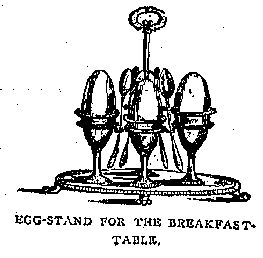
1656.
Eggs for boiling cannot be too fresh, or boiled too soon after they are laid; but rather a longer time should be allowed for boiling a new-laid egg than for one that is three or four days old. Have ready a saucepan of boiling water; put the eggs into it gently with a spoon, letting the spoon touch the bottom of the saucepan before it is withdrawn, that the egg may not fall, and consequently crack. For those who like eggs lightly boiled, 3 minutes will be found sufficient; 3-3/4 to 4 minutes will be ample time to set the white nicely; and, if liked hard, 6 to 7 minutes will not be found too long. Should the eggs be unusually large, as those of black Spanish fowls sometimes are, allow an extra 1/2 minute for them. Eggs for salads should be boiled from 10 minutes to 1/4 hour, and should be placed in a basin of cold water for a few minutes; they should then be rolled on the table with the hand, and the shell will peel off easily.Time
.-- To boil eggs lightly, for invalids or children, 3 minutes; to boil eggs to suit the generality of tastes, 3-3/4 to 4 minutes; to boil eggs hard, 6 to 7 minutes; for salads, 10 to 15 minutes.Note
.-- Silver or plated egg-dishes, like that shown in our engraving, are now very much used. The price of the one illustrated is £2. 2s., and may be purchased of Messrs. R. & J. Slack, 336, Strand.EGGS.-- When fresh eggs are dropped into a vessel full of boiling water, they crack, because the eggs being well filled, the shells give way to the efforts of the interior fluids, dilated by heat. If the volume of hot water be small, the shells do not crack, because its temperature is reduced by the eggs before the interior dilation can take place. Stale eggs, again, do not crack, because the air inside is easily compressed.
BUTTERED EGGS.
1657.
INGREDIENTS.-- 4 new-laid eggs, 2 oz. of butter.Mode
.-- Procure the eggs new-laid if possible; break them into a basin, and beat them well; put the butter into another basin, which place in boiling water, and stir till the butter is melted. Pour that and the eggs into a lined saucepan; hold it over a gentle fire, and, as the mixture begins to warm, pour it two or three times into the basin, and back again, that the two ingredients may be well incorporated. Keep stirring the eggs and butter one way until they are hot, without boiling, and serve on hot buttered toast. If the mixture is allowed to boil, it will curdle, and so be entirely spoiled.Time
.-- About 5 minutes to make the eggs hot. Average cost, 7d.Sufficient
.-- Allow a slice to each person. Seasonable at any time.DUCKS' EGGS.
1658.
Ducks' eggs are usually so strongly flavoured that, plainly boiled, they are not good for eating; they answer, however, very well for various culinary preparations where eggs are required; such as custards, &c. &c. Being so large and highly-flavoured, 1 duck's egg will go as far as 2 small hen's eggs; besides making whatever they are mixed with exceedingly rich. They also are admirable when used in puddings.PRIMITIVE METHOD OF COOKING EGGS.-- The shepherds of Egypt had a singular manner of cooking eggs without the aid of fire. They placed them in a sling, which they turned so rapidly that the friction of the air heated them to the exact point required for use.
FRIED EGGS.
1659.
INGREDIENTS.-- 4 eggs, 1/4 lb. of lard, butter or clarified dripping.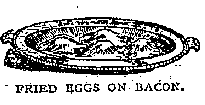
Mode.-- Place a delicately-clean frying-pan over a gentle fire; put in the fat, and allow it to come to the boiling-point. Break the eggs into cups, slip them into the boiling fat, and let them remain until the whites are delicately set; and, whilst they are frying, ladle a little of the fat over them. Take them up with a slice, drain them for a minute from their greasy moisture, trim them neatly, and serve on slices of fried bacon or ham; or the eggs may be placed in the middle of the dish, with the bacon put round as a garnish.
Time
.-- 2 to 3 minutes. Average cost, 1d. each; 2d. when scarce.Sufficient
for 2 persons. Seasonable at any time.VENERATION FOR EGGS.-- Many of the most learned philosophers held eggs in a kind of respect, approaching to veneration, because they saw in them the emblem of the world and the four elements. The shell, they said, represented the earth; the white, water; the yolk, fire; and air was found under the shell at one end of the egg.
EGGS A LA MAITRE D'HOTEL.
1660.
INGREDIENTS.-- 1/4 lb. of fresh butter, 1 tablespoonful of flour, 1/2 pint of milk, pepper and salt to taste, 1 tablespoonful of minced parsley, the juice of 1/2 lemon, 6 eggs.Mode
.-- Put the flour and half the butter into a stewpan; stir them over the fire until the mixture thickens; pour in the milk, which should be boiling; add a seasoning of pepper and salt, and simmer the whole for 5 minutes. Put the remainder of the butter into the sauce, and add the minced parsley; then boil the eggs hard, strip off the shells, cut the eggs into quarters, and put them on a dish. Bring the sauce to the boiling-point, add the lemon-juice, pour over the eggs, and serve.Time
.-- 5 minutes to boil the sauce; the eggs, 10 to 15 minutes.Average cost
, 1s.Sufficient
for 4 or 5 persons. Seasonable at any time.OEUFS AU PLAT, or AU MIROIR, served on the Dish in which they are Cooked.
1661.
INGREDIENTS.-- 4 eggs, 1 oz. of butter, pepper and salt to taste.Mode
.-- Butter a dish rather thickly with good fresh butter; melt it, break the eggs into it the same as for poaching, sprinkle them with white pepper and fine salt, and put the remainder of the butter, cut into very small pieces, on the top of them. Put the dish on a hot plate, or in the oven, or before the fire, and let it remain until the whites become set, but not hard, when serve immediately, placing the dish they were cooked in on another. To hasten the cooking of the eggs, a salamander may be held over them for a minute; but great care must be taken that they are not too much done. This is an exceedingly nice dish, and one very easily prepared for breakfast.Time
.-- 3 minutes. Average cost, 5d.Sufficient
for 2 persons. Seasonable at any time.PLOVERS' EGGS.
1662.
Plovers' eggs are usually served boiled hard, and sent to table in a napkin, either hot or cold. They may also be shelled, and served the same as eggs à la Tripe, with a good Béchamel sauce, or brown gravy, poured over them. They are also used for decorating salads, the beautiful colour of the white being generally so much admired.POACHED EGGS.

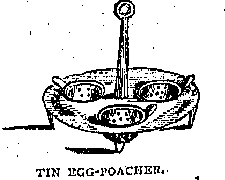
1663.
INGREDIENTS.-- Eggs, water. To every pint of water allow 1 tablespoonful of vinegar.Mode
.-- Eggs for poaching should be perfectly fresh, but not quite new-laid; those that are about 36 hours old are the best for the purpose. If quite new-laid, the white is so milky it is almost impossible to set it; and, on the other hand, if the egg be at all stale, it is equally difficult to poach it nicely. Strain some boiling water into a deep clean frying-pan; break the egg into a cup without damaging the yolk, and, when the water boils, remove the pan to the side of the fire, and gently slip the egg into it. Place the pan over a gentle fire, and keep the water simmering until the white looks nicely set, when the egg is ready. Take it up gently with a slice, cut away the ragged edges of the white, and serve either on toasted bread or on slices of ham or bacon, or on spinach, &c. A poached egg should not be overdone, as its appearance and taste will be quite spoiled if the yolk be allowed to harden. When the egg is slipped into the water, the white should be gathered together, to keep it a little in form, or the cup should be turned over it for 1 minute. To poach an egg to perfection is rather a difficult operation; so, for inexperienced cooks, a tin egg-poacher may be purchased, which greatly facilitates this manner of dressing ecgs. Our illustration clearly shows what it is: it consists of a tin plate with a handle, with a space for three perforated cups. An egg should be broken into each cup, and the machine then placed in a stewpan of boiling water, which has been previously strained. When the whites of the eggs appear set, they are done, and should then be carefully slipped on to the toast or spinach, or with whatever they are served. In poaching eggs in a frying-pan, never do more than four at a time; and, when a little vinegar is liked mixed with the water in which the eggs are done, use the above proportion.Time
.-- 2-1/2 to 3-1/2 minutes, according to the size of the egg.Sufficient
.-- Allow 2 eggs to each person.Seasonable
at any time, but less plentiful in winter.POACHED EGGS, WITH CREAM.
1664.
INGREDIENTS.-- 1 pint of water, 1 teaspoonful of salt, 4 teaspoonfuls of vinegar, 4 fresh eggs, 1/2 gill of cream, salt, pepper, and pounded sugar to taste, 1 oz. of butter.Mode
.-- Put the water, vinegar, and salt into a frying-pan, and break each egg into a separate cup; bring the water, &c. to boil, and slip the eggs gently into it without breaking the yolks. Simmer them from 3 to 4 minutes, but not longer, and, with a slice, lift them out on to a hot dish, and trim the edges. Empty the pan of its contents, put in the cream, add a seasoning to taste of pepper, salt, and pounded sugar; bring the whole to the boiling-point; then add the butter, broken into small pieces; toss the pan round and round till the butter is melted; pour it over the eggs, and serve. To insure the eggs not being spoiled whilst the cream, &c., is preparing, it is a good plan to warm the cream with the butter, &c., before the eggs are poached, so that it may be poured over them immediately after they are dished.Time
.-- 3 to 4 minutes to poach the eggs, 5 minutes to warm the cream.Average cost
for the above quantity, 9d.Sufficient
for 2 persons. Seasonable at any time.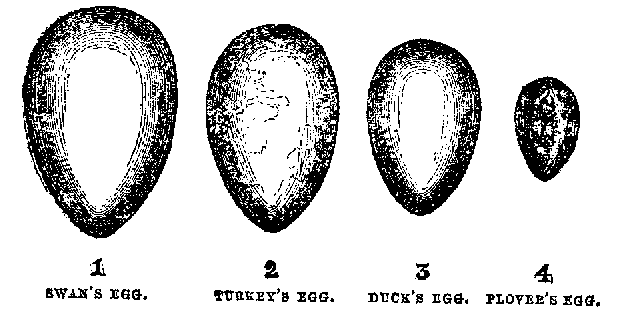
SCOTCH EGGS.
1666.
INGREDIENTS.-- 6 eggs, 6 tablespoonfuls of forcemeat No. 417, hot lard, 1/2 pint of good brown gravy.Mode
.-- Boil the eggs for 10 minutes; strip them from the shells, and cover them with forcemeat made by recipe No. 417; or substitute pounded anchovies for the ham. Fry the eggs a nice brown in boiling lard, drain them before the fire from their greasy moisture, dish them, and pour round from 1/4 to 1/2 pint of good brown gravy. To enhance the appearance of the eggs, they may be rolled in beaten egg and sprinkled with bread crumbs; but this is scarcely necessary if they are carefully fried. The flavour of the ham or anchovy in the forcemeat must preponderate, as it should be very relishing.Time
.-- 10 minutes to boil the eggs, 5 to 7 minutes to fry them.Average cost
, 1s. 4d.Sufficient
for 3 or 4 persons. Seasonable at any time.EGGS A LA TRIPE.
1667.
INGREDIENTS.-- 8 eggs, 3/4 pint of Béchamel sauce No. 368, dessertspoonful of finely-minced parsley.Mode
.-- Boil the eggs hard; put them into cold water, peel them, take out the yolks whole, and shred the whites. Make 3/4 pint of Béchamel sauce by recipe No. 368; add the parsley, and, when the sauce is quite hot, put the yolks of the eggs into the middle of the dish, and the shred whites round them; pour over the sauce, and garnish with leaves of puff-paste or fried croûtons. There is no necessity for putting the eggs into the saucepan with the Béchamel; the sauce, being quite hot, will warm the eggs sufficiently.Time
.-- 10 minutes to boil the eggs.Average cost
, 1s.Sufficient
for 5 or 6 persons.Seasonable
at any time.